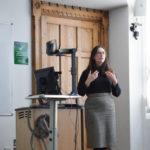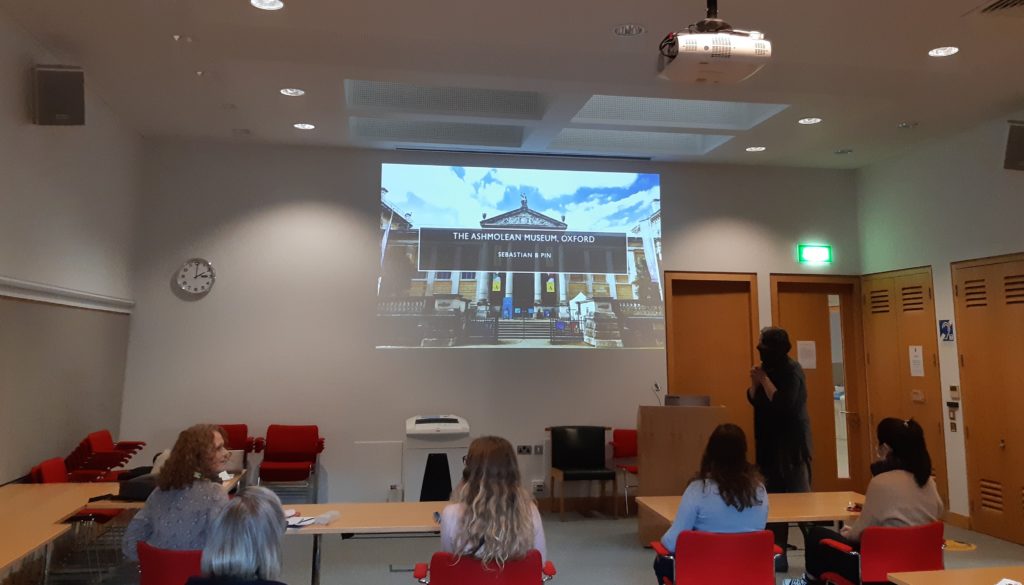
by Camille Lafrance, Second year student, MPhil Textile Conservation
It is not common for a student to have the opportunity to do a presentation more than once; presentations are often forgotten soon after they are given. During our busy semesters, there are never enough chances to reflect further on the feedback received and go back to the content of a ‘one-time’ presentation. Comments can be indeed considered in following projects, but I have recently come to fully realise that there are many benefits from repetition.
Over the past few months, I have had the opportunity to present my placement experience at Zenzie Tinker Conservation Ltd three times: first at the University of Glasgow for the placement presentations, then at the first annual Emerging Conservators Symposium of the Canadian Association for Conservation of Cultural Property, and finally at the British Library for the trustees of the Zibby Garnett Travel Fellowship who had generously supported my placement.
To summarise my summer 2021, I had the enriching opportunity to work with Zenzie Tinker and her team for two months on a variety of site works, such as the vacuuming of Morris&Co wall coverings at The Ironmonger’s Hall in London; condition checking Lee Miller’s clothes at Farleys House and Gallery; and bringing down military colours at Saint-Paul’s Cathedral. Alongside these siteworks and one day of tapestry conservation, I spent most of my time on the treatment of a naval dress coat from the early 20th century.



Activities undertaken on my placement © Zenzie Tinker Conservation with permission of the client, 2021.
The second presentation of my placement experience was delivered online at The Emerging Conservators Symposium of the Canadian Association for Conservation on October 23, 2021. Recent graduates and students from the Cultural Heritage Conservation and Management programme at Fleming College (Canada); the Master of Art Conservation at Queen’s University (Canada); and the Master of Philosophy in Textile Conservation at the University of Glasgow, were invited to share their experience, special projects, and internships, touching on a wide range of topics including painting, paper, photography, textile, and preventive conservation. The morning session combined presentations on networking; balancing the ethics of preventive and interventive conservation; and the preparation of digitally created infills for paper artefacts. The pre-lunch session started with Anna Robinson (MPhil 2021), recent graduate of the course, who presented her dissertation project which she named for the occasion “Starch Struck: a preliminary investigation of the use of wet cleaning to reduce starch finishes in historic textiles”. Her presentation was followed by talks on the conversion of digital colour scales to facilitate physical colour mixing and a study of the material properties of Fresh Canadian Isinglass as a sustainable alternative to European products.
During the last session, I shared my placement experience in a presentation titled “Private clients, local museums, and national institutions – A student experience in a private conservation studio specialised in textiles”. As a Canadian student in Glasgow, the symposium was a great and rare opportunity to connect with fellow emerging conservators from my home country. Also, this second version of my presentation highly benefited from the feedback of my course tutors and Zenzie Tinker given following the placement presentations at the university. Feedback is key to improvement and most useful! Whilst focused and deep in a conservation project, it is easy to forget that different audiences do not necessarily know all the elements considered in the decision-making of an object’s treatment. In this instance, I learned that discussing why I had taken such steps, why I had made such decisions and explaining my treatment rationale is foremost important whilst presenting my work to non-specialists and clients.


Third Time’s the Charm. On January 26, 2022, I had the chance to take a day trip to the British Library, London to present my placement experience to the Trustees of the Zibby Garnett Travel Fellowship (ZGTF). For the occasion, trustees and conservators from the British Library joined the meeting to learn about the projects undertaken by the ZGTF scholars over the summer 2021. Sebastian Blue Pin, fellow second-year student who attended virtually, and I had the opportunity to share with them our experience, learning outcomes, and cultural excursions taken over the course of our placements.

The ZGTF is a charity founded in 2000 in memory of Zibby Garnett who coordinated the Historic Decorative Crafts course at the Lincolnshire College of Art and Design (later part of Lincoln University). Over the years, numerous students from the MPhil Textile Conservation in Glasgow as well as back to the Textile Conservation Centre at the University of Southampton have been funded by the charity to undertake practical study and conservation work in countries outside the United Kingdom and due to the ongoing pandemic, the ZGTF accepted applications in 2021 for projects occurring in the UK. I was delighted to attend the meeting to acknowledge and show my appreciate for the long-standing and generous support of ZGTF towards the students of the Textile Conservation course.
As a shy person uncomfortable in social gatherings and not very confident at talking to strangers, these three events have been opportunities to ‘get out there’ which is a necessary step to take as an emerging conservator. As underlined before, students rarely share more than once their academic projects, but I highly recommend it! This repeated opportunity has been an interesting chance to improve my presentation skills but also to consider how I convey a very important experience in my academic and professional development to different audiences. Overall, the whole experience, from the placement itself to the triple presentation, has been a welcome learning process.

